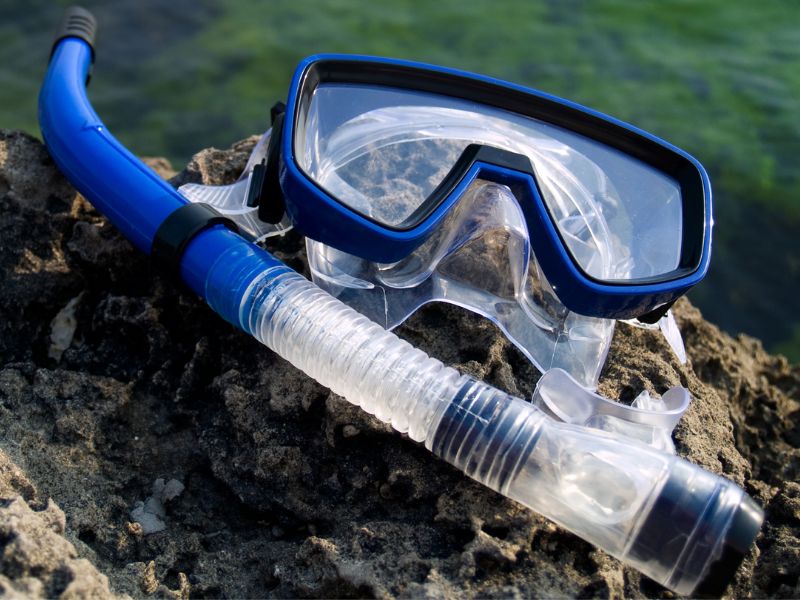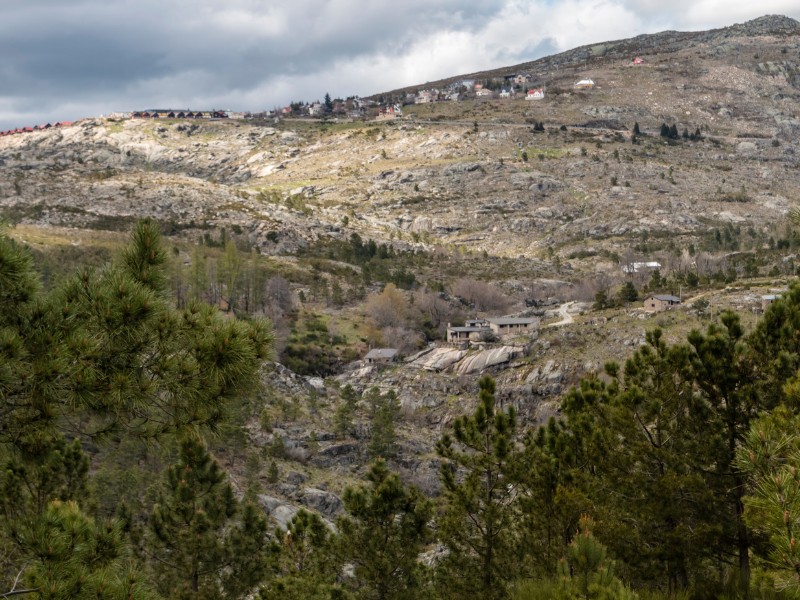Situated at the crossroads of Central and Southeast Europe, Croatia is a land resplendent with natural beauty and a wealth of cultural richness. A picturesque tapestry woven with azure waters, sprawling vineyards, and timeless historical architecture, it stands as an epitome of Europe’s unspoiled allure. Home to more than a thousand islands and a plethora of UNESCO World Heritage Sites, Croatia is a quintessential destination, imbued with breathtaking landscapes and vibrant cities that carry tales from its ancient past up to its cosmopolitan present.
From its sun-drenched coastline along the Adriatic Sea, dotted with medieval towns and serene beaches, to its inland areas brimming with awe-inspiring national parks and mesmerizing lakes, Croatia encapsulates a unique blend of pristine nature and carefully preserved history. Every corner of this splendid country tells a story, a narrative filled with distinctive traditions, appetizing gastronomy, and rich cultural heritage. Here are the most beautiful destinations to visit in Croatia.
source: Scenic Hunter on YouTube
A Panorama of Top Ten Stunning Destinations
Embarking on an exploration of Croatia unveils an array of idyllic locales that leave an indelible impression on every traveller. Each destination mentioned in this guide holds a myriad of experiences, waiting to be discovered and treasured. Herein, we delve into an immersive journey through the ten most stunningly beautiful destinations of Croatia – a handpicked selection that includes the enchanting isles of Hvar, Brac, and Korcula; the captivating cities of Dubrovnik and Split; the astonishing natural spectacles of Plitvice Lakes and Krka National Park; and the enchanting towns of Rovinj, Pula, and Zadar.
These destinations, diverse in their offerings yet united in their exceptional charm, weave together a captivating narrative of Croatian allure. As we venture forth into the realm of their profound beauty and captivating history, we’ll discover a Croatia lesser-known and extensively cherished. Whether you’re a seasoned globetrotter or a curious novice, this exploration will kindle a profound sense of wonder, making you fall head over heels for the compelling beauty that Croatia possesses.
So, let us set sail on this voyage through the depths of Croatia’s most resplendent landscapes and landmarks, unearthing the captivating stories that lie at the heart of these ten breathtaking destinations.
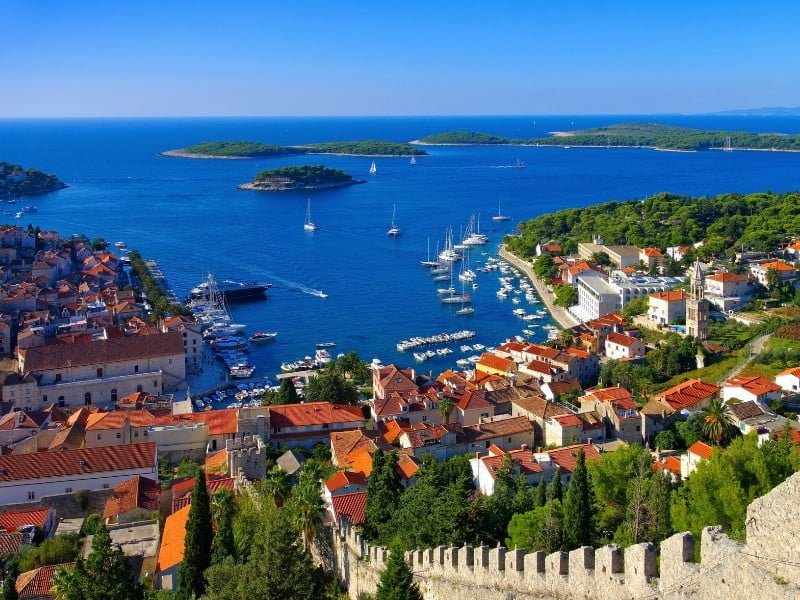
Hvar
An Ode to Hvar: The Island’s Unique Charm and Geographic Splendour
Perched in the Adriatic Sea’s tranquil waters, off Croatia’s Dalmatian Coast, resides the sun-kissed island of Hvar. Known as the sunniest spot in the country, Hvar is renowned for its perennially warm, Mediterranean climate, which nurtures an Eden of lavender fields, olive groves, and vineyards across its lush landscape. Its magnificent geographic location renders it a paradisiacal retreat, an isle graced with vibrant azure waters, ivory-pebbled beaches, and an undulating terrain carpeted with a myriad of vibrant hues. Hvar is also an island with rich culture and history.
Hvar’s intrinsic charm transcends its natural beauty, extending to the architectural gems and historical narratives encapsulated within its ancient stone walls. The island’s unique qualities are indeed a harmonious blend of nature’s grandeur and mankind’s legacy, making it a compelling destination for wanderers seeking the beauty of the past within the splendour of the present.
source: Samuel and Audrey on YouTube
Hvar’s Historical and Natural Highlights: A Tapestry of Timeless Beauty
A sojourn through Hvar unveils an assortment of captivating sights and engaging activities. Towering over the quaint, picturesque town of Hvar is the medieval Fortica Fortress. Also known as Spanjola, this historical monument offers a sweeping panorama of the city, the azure sea, and the Pakleni islands, making it an unmissable spot for those wishing to immerse themselves in Hvar’s heart-stirring landscapes.
Further enriching the island’s architectural charm is the Hvar Cathedral, standing tall as a testimony to the region’s rich ecclesiastical history. Its Renaissance-style facade, complemented by an interior adorned with Venetian paintings, provides a serene refuge for appreciators of art and history.
Hvar’s geographical beauty is not confined to its vibrant inland but extends to its stunning coastlines adorned with exquisite beaches. From the secluded Dubovica to the bustling Hvar Beach, each seashore presents an idyllic setting for basking under the Mediterranean sun, immersing in water sports, or simply reveling in the island’s tranquil beauty.
A Dive into Hvar’s Local Culture and Gastronomy
The beauty of Hvar extends beyond its sceneries and structures, seeping into the fabric of its local culture and culinary traditions. The islanders’ lifestyle, deeply intertwined with the land and sea, reflects a tapestry of traditions passed down through generations. The cultural scene is rich with folklore performances, religious processions, and time-honored festivals like the Lavender Festival, celebrating the island’s famed lavender harvest.
Hvar’s culinary scene is a gastronomic delight, serving a medley of authentic Dalmatian dishes that reflect its rich marine and agricultural bounty. The island is particularly known for its exceptional seafood and wines. Savory dishes of grilled fish, shellfish stew (gregada), and octopus salad are must-tries for any gastronome. Moreover, a visit to Hvar is incomplete without savoring the local wines – especially the robust reds of Plavac Mali or the aromatic whites of Bogdanuša, cultivated in Hvar’s own vineyards.
Embracing Hvar’s beauty, therefore, lies not just in observing its scenic and architectural marvels but in experiencing its vibrant local culture and indulging in its flavorful gastronomy, embodying the true essence of the island.
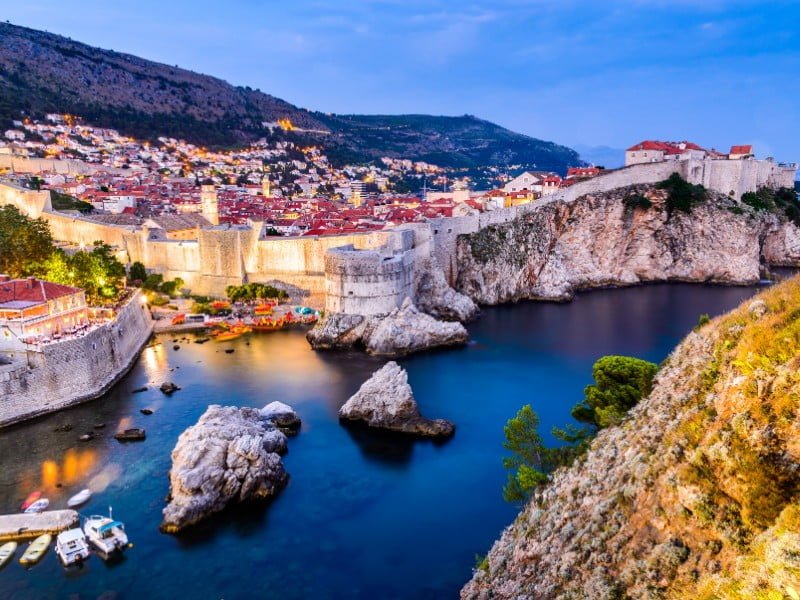
Dubrovnik
Dubrovnik: The Exquisite “Pearl of the Adriatic”
Nestled along the Dalmatian Coast, bordering the glistening Adriatic Sea, lies the radiant city of Dubrovnik. Revered as the “Pearl of the Adriatic,” Dubrovnik is a mesmerizing embodiment of architectural splendor, historical grandeur, and cultural opulence. Its remarkable preservation of ancient city walls, baroque buildings, and cobblestone streets resonate with tales from a bygone era, beautifully juxtaposed against the backdrop of a vibrant, modern city.
source: Samuel an Audrey on YouTube
The charm of Dubrovnik is multi-faceted, derived from its stunning coastal position, which affords panoramic sea views, as well as its rich cultural heritage, which spans centuries of tumultuous and triumphant history. Visitors find themselves entranced by the city’s enchanting allure, its magnetic beauty amplified by the golden glow of the sun striking its ancient stone walls, lending a sense of timelessness to this coastal paradise. To make the most of your adventure, you can enjoy luxury sailing around Croatia from Dubrovnik, an ideal option for visitors who want to see more of the country.
Discovering the Majestic Landmarks of Dubrovnik
A tour around Dubrovnik unravels a plethora of remarkable attractions. The iconic City Walls, which encircle the Old Town, serve as a lasting testament to the city’s historical strength and fortitude. These robust fortifications offer a picturesque walking path, bestowing splendid views over the terra-cotta rooftops, narrow alleyways, and the infinite Adriatic Sea.
Within these walls, the Old Town itself is a treasure trove of historical and architectural gems. The pedestrian-only, marble-paved Stradun (or Placa), lined with outdoor cafes and shops, is the city’s pulsating artery. Gothic, Renaissance, and Baroque churches, monasteries, and palaces, such as the Rector’s Palace and the Sponza Palace, further elevate the city’s aesthetic appeal.
Overlooking the Old Town, the Lovrijenac Fortress, or the “Gibraltar of Dubrovnik,” tells tales of the city’s resilient defense against invasions. This imposing fort, perched on a 37-meter-high rock, is not only a symbol of liberty and power but also a venue for cultural and artistic events, notably the Dubrovnik Summer Festival.
Dubrovnik: A UNESCO World Heritage Site and a Cultural Icon
Dubrovnik’s illustrious heritage and well-preserved Old Town led to its designation as a UNESCO World Heritage Site in 1979. UNESCO describes it as an “outstanding medieval, Renaissance and Baroque city, a marvel of urban continuity and architectural coherence.”
Apart from its historical and architectural renown, Dubrovnik has etched its mark on popular culture as a prominent filming location. The city, with its medieval charm, has served as the picturesque backdrop for numerous films and television series. Notably, it has been immortalized as ‘King’s Landing’ in HBO’s fantasy epic “Game of Thrones”. Fans of the show flock to the city for guided tours that showcase iconic filming locations, thus intertwining the realms of fantasy and reality in this timeless city.
In essence, Dubrovnik, with its captivating beauty, historical richness, and cultural significance, stands as a compelling testament to Croatia’s multifaceted allure, promising a riveting exploration to all who step into its enchanting realm.

Split
Split: A Timeless Symphony of Ancient and Modern
Gracing the eastern shores of the Adriatic Sea is Split, a city that weaves a captivating narrative of timeless elegance and contemporary vibrancy. The second-largest city in Croatia, Split is an idyllic blend of the old and new, where ancient palaces echo tales of a bygone era while bustling cafes and shops hum with the rhythm of modern life.
Founded by the Romans over 1,700 years ago, the city’s rich history is gracefully etched into its weathered stone walls, while its dynamic spirit is mirrored in its bustling ports, lively beaches, and thriving arts scene. Split stands as a testament to the harmonious fusion of the past with the present, the traditional with the cosmopolitan, encapsulating an enchanting allure that beckons travelers from around the globe.
source: Samuel and Audrey on YouTube
Iconic Attractions in Split: A Tryst with History and Nature
At the heart of Split’s historical charm lies Diocletian’s Palace, an architectural marvel built in the 4th century by Roman Emperor Diocletian. Today, this UNESCO World Heritage Site stands not as a mere monument but as a living entity, with residences, shops, restaurants, and bars nestled within its ancient walls. Exploring the palace unveils a maze of narrow alleys, hidden courtyards, and iconic sites such as the Peristyle square, the Cathedral of St. Domnius, and the Temple of Jupiter.
Running parallel to the southern wall of Diocletian’s Palace is the Riva Promenade, the city’s lively waterfront. This bustling esplanade, lined with palm trees, cafes, and stalls, provides a charming vista of the harbor, making it a perfect locale for leisurely strolls and people-watching.
Beyond the city’s historic center, the verdant Marjan Park offers a tranquil escape. This “lungs of the city,” as locals fondly call it, is a hill covered with dense Mediterranean pine forest, crisscrossed with jogging trails and offering panoramic views of the city, the sea, and the islands. The park is dotted with ancient chapels and hermitages, adding a touch of historical allure to its natural beauty. You can admire the city’s spectacular views and UNESCO-listed sites.
The Pulse of Split: Local Gastronomy and Vibrant Nightlife
Split’s vibrant character extends to its culinary scene and nightlife, offering delightful gastronomic experiences and an energetic after-dark ambiance. The local cuisine is a delicious blend of Dalmatian and Mediterranean flavors, with fresh seafood, grilled meats, local cheeses, and divine wines taking center stage. Traditional taverns, known as ‘konobas,’ serve authentic dishes such as ‘peka’ (meat or seafood cooked under a bell-shaped lid) and ‘soparnik’ (Swiss chard-filled flatbread), offering a true taste of Split’s culinary heritage.
As twilight descends, Split reveals its vibrant nightlife, bustling with lively bars, dance clubs, and music festivals. Whether it’s sipping cocktails in a chic sea-facing lounge or dancing the night away at a beachfront club, the city’s nocturnal scene caters to every mood and preference.
Split, with its dynamic blend of history, modernity, and vibrant culture, unfolds as a city of endless discoveries, promising an enriching and memorable sojourn for all who venture into its inviting embrace.

Brac
Brac: An Enchanting Odyssey in Central Dalmatia
Set against the vibrant backdrop of the Adriatic Sea lies the island of Brac, a gem in central Dalmatia’s crown. The largest island in the region, Brac is a natural paradise, known for its golden beaches, azure coves, and vine-covered hills. Boasting a rich history dating back to the Roman era, the island seamlessly blends its scenic beauty with cultural traditions, architectural marvels, and gastronomic delights.
With its quiet towns, secluded beaches, and idyllic landscapes, Brac beckons those seeking a serene getaway amidst nature’s embrace. The island’s tranquil charm, the warmth of its people, and the allure of its cultural heritage together create an enchanting tapestry of experiences that leave an indelible imprint on the heart of every traveler. You will find many excellent villa rentals in Croatia, with Brac being a favoured destination.
source: Lana Tiare on YouTube
The Allure of Zlatni Rat and Brac’s Natural Wonders
Dominating Brac’s natural attractions is the iconic Zlatni Rat Beach. Known as the Golden Cape, this pebbly beach is famed for its unique shape, a v-shaped spit of land that changes with the tide, currents, and wind. Nestled near the town of Bol, Zlatni Rat stands as a mesmerizing spectacle of nature, its crystal-clear waters offering perfect conditions for windsurfing and other water sports.
Beyond the allure of Zlatni Rat, Brac is embellished with an array of natural wonders. From its limestone caves such as Dragon’s Cave, adorned with curious carvings, to its Vidova Gora, the highest peak among the Adriatic islands, offering panoramic vistas over the sea and surrounding islands, the island is a paradise for nature enthusiasts and adventure seekers.
Embracing Brac’s Cultural Heritage: Olive Oil and Stone Carving
The cultural tapestry of Brac is woven with threads of traditional crafts and time-honored gastronomy. The island is renowned for its centuries-old olive oil production. A journey across its verdant landscapes reveals sprawling olive groves, their bountiful harvest yielding some of the finest olive oil in Croatia. The Olive Oil Museum in Skrip offers fascinating insights into this tradition, allowing visitors to experience the oil-making process and indulge in tastings.
Equally integral to Brac’s identity is its tradition of stone carving. The island’s white stone, known as Brački kamen, is prized for its quality and has been used in notable structures, including the Diocletian’s Palace in Split and the White House in Washington, DC. A visit to the Stonemasonry School in Pucisca provides a glimpse into this age-old craft, with artisans showcasing the intricate process of shaping this famed stone.
Brac, with its myriad of natural splendors, cultural richness, and welcoming atmosphere, stands as a compelling embodiment of Croatia’s intrinsic charm. Its enchanting landscapes, traditional practices, and serene ambiance promise a captivating and rewarding experience for all who set foot on its shores.

Korcula
Korcula: A Dazzling Tapestry of Vineyards, Olive Groves, and Charming Villages
Immersed in the turquoise waters of the Adriatic, Korcula unfolds as an idyllic spectacle of verdant vineyards, olive groves, and quaint villages. Often referred to as “Little Dubrovnik” due to its fortified town, Korcula stands as the sixth-largest island in Croatia, offering an intriguing blend of untouched nature, centuries-old traditions, and rich cultural heritage. Unlike the Old Town of Dubrovnik, Korcula’s Old Town is small and compact, making it easier to explore on foot.
The island’s lush landscapes are punctuated by beautiful sandy and pebbly beaches, secluded coves, and impressive stone architecture. Its hinterlands reveal an expanse of dense forest and agricultural wealth, while the island’s coastline is adorned with charming fishing villages and bustling seaside towns. These compelling facets of Korcula come together to paint a picturesque tableau of tranquil island life, inviting travelers to step into a world where time seems to stand still.
source: Sail Croatia on YouTube
The Medieval Enchantment of Korcula Town: Birthplace of Marco Polo
The heart of Korcula beats in its medieval Korcula Town, a beautifully preserved fortified settlement perched on a peninsula. Enclosed by honey-colored stone walls and towers, the town is a labyrinth of narrow, herringbone pattern streets filled with Gothic and Renaissance buildings, creating an atmosphere reminiscent of a time long past.
One of the town’s most intriguing claims is being the reputed birthplace of the famed explorer Marco Polo. The Marco Polo House, although now mostly a ruin, continues to draw curious travelers eager to delve into the life and journeys of this illustrious voyager.
Savoring Korcula’s Culinary Delights: The Exquisite Posip
The culinary realm of Korcula is a delightful symphony of flavors, with local gastronomy deeply influenced by the island’s fertile lands and bountiful sea. Traditional dishes brimming with fresh seafood, local herbs, and farm-fresh produce offer an authentic taste of Dalmatian cuisine.
Yet, the true culinary star of Korcula is its celebrated white wine, Posip. This indigenous grape variety flourishes in the island’s sun-drenched vineyards, producing a full-bodied and aromatic wine recognized and appreciated far beyond Croatia’s borders. A visit to a local winery offers not just a tasting of this exquisite wine, but also a deep insight into the island’s viticulture and the centuries-old traditions of winemaking.
In essence, Korcula, with its natural beauty, medieval charm, and culinary delights, stands as a fascinating destination in Croatia. Its stunning landscapes, rich history, and vibrant food and wine scene invite travelers to immerse themselves in an authentic and memorable island experience.

Plitvice Lakes National Park
Plitvice Lakes National Park: A UNESCO World Heritage Site of Breathtaking Natural Beauty
Nestled within the mountainous karst area of central Croatia lies the Plitvice Lakes National Park, a verdant sanctuary renowned for its ethereal beauty. This UNESCO World Heritage site, stretching over an area of nearly 300 square kilometers, unfolds as a vibrant canvas of cascading lakes, gushing waterfalls, and lush woodland, offering a visual spectacle that captivates and enthralls at every turn.
Boasting a diverse topography and a plethora of geological phenomena, the park is a testament to the creative power of nature. Its stunning landscapes, marked by geological formations and unique vegetation, present an awe-inspiring vista that resonates with the profound harmony of nature’s elements.
source: Gareth Leonard on YouTube
A Symphony of Lakes, Waterfalls, and Rich Wildlife
The defining feature of Plitvice Lakes National Park is its system of 16 terraced lakes, interconnected by a series of waterfalls and set in deep woodland populated by an impressive array of wildlife. Ranging from azure to green, grey, or blue, the lakes owe their mesmerizing colors to the minerals and organisms in the water and the angle of sunlight.
The breathtaking spectacle of waterfalls, ranging from thundering cascades to gentle trickles, contributes to the magical ambiance of the park. The Veliki Slap, the largest waterfall in the park, plummets from a height of 78 meters, creating a mesmerizing spectacle of force and beauty.
This aquatic wonderland is home to an abundance of wildlife. Brown bears, wolves, eagles, owls, and over 120 species of birds reside in the surrounding forests, while the waters teem with different types of fish, including the endemic Plitvice trout.
An Adventurer’s Paradise: Hiking Trails and Photographic Opportunities
The natural grandeur of Plitvice Lakes National Park offers a myriad of opportunities for exploration and photography. Marked hiking trails lead visitors around and across the water, through woodland, and up to some of the park’s best vantage points. These trails, ranging from easy walks to more challenging hikes, cater to all fitness levels, allowing everyone to experience the park’s exceptional beauty.
The park’s picturesque landscapes, brimming with breathtaking vistas of cascading waters, shimmering lakes, and dense forests, provide stunning backdrops for photography. From the delicate morning light filtering through the trees to the spectacular sunsets painting the sky in hues of gold and crimson, every moment in this enchanting wilderness invites a capture that speaks a thousand words.
Plitvice Lakes National Park, with its dazzling display of natural beauty, diverse flora and fauna, and myriad of outdoor activities, offers a unique and memorable exploration of Croatia’s natural treasures. Its enchanting vistas, tranquil ambiance, and captivating wildlife encounters make it a must-visit destination for nature lovers and photographers alike.

Rovinj
Rovinj: Istria’s Romantic Masterpiece
Emerging from the sparkling waters of the Adriatic Sea is the captivating town of Rovinj. Located on the western coast of the Istrian peninsula, Rovinj, often referred to as the most romantic place in the Mediterranean, is a jewel of Croatian culture and heritage. The town is a delightful fusion of historic charm, vibrant arts, and gourmet delights, entwined within a framework of radiant sunsets and inviting beaches.
An enchanting destination, Rovinj offers an irresistible allure to those seeking a blend of captivating history, exquisite architecture, and gastronomic adventures. It paints a picturesque tableau of life in a bygone era, providing an idyllic backdrop for unforgettable experiences.
source: Samuel an Audrey on YouTube
A Tapestry of Venetian Architecture, Vibrant Art Scene, and Cobblestone Streets
Rovinj’s architecture is a testament to its Venetian past, with pastel-hued buildings, ornate facades, and the iconic St. Euphemia Church, which proudly dominates the town’s skyline. The narrow cobblestone streets, winding their way through the old town and leading up to the hilltop church, are adorned with historic houses closely huddled against each other, evoking the atmosphere of an open-air museum.
At the heart of Rovinj is a vibrant art scene. Numerous galleries and studios scattered across the town pay homage to local and international artists, their works ranging from traditional to contemporary. The town also hosts the annual Rovinj Photodays, a prestigious photography festival that attracts participants from across the globe.
Culinary Journey: Rovinj’s Gastronomy Influenced by Italian Cuisine
The gastronomic scene in Rovinj is a delectable fusion of Croatian and Italian flavors, reflecting the town’s rich cultural tapestry. Seafood takes center stage, fresh from the day’s catch and cooked to perfection, while truffles, olives, and world-class wines from the fertile Istrian hinterland complete the culinary mosaic.
Restaurants and konobas (traditional taverns) nestled in narrow alleys or along the bustling harbor offer mouth-watering dishes such as fuzi (hand-rolled pasta) with truffles, brodet (fish stew), and Istrian prosciutto. Paired with a glass of Malvazija or Teran, local wines, these delicacies provide a true taste of Rovinj’s culinary heritage.
Rovinj, with its charming blend of history, art, and cuisine, stands as a captivating destination in the heart of Istria. The town’s enchanting architecture, rich cultural scene, and tantalizing gastronomy offer a unique and unforgettable journey into the soul of the Adriatic.

Pula
Pula: A Seafront City Echoing Roman Grandeur
On the southern tip of the Istrian peninsula, caressed by the azure waves of the Adriatic, stands the ancient city of Pula. Known for its stunningly preserved Roman ruins and vibrant cultural scene, Pula serves as an intriguing fusion of past and present, where echoes of the ancient world intertwine with the rhythmic pulse of modern urban life.
Steeped in millennia of history, Pula unfolds as a living museum under the open sky, its rich architectural heritage and profound cultural vibrancy resonating through the city’s sun-drenched streets and charming plazas. This ancient city, once an important strategic location in the Roman Empire, is now a treasure trove of historical and cultural experiences.
source: Samuel and Audrey on YouTube
Walking Through Time: Pula Arena, The Temple of Augustus, and Other Archaeological Marvels
The city’s landscape is punctuated by Roman ruins, the most spectacular of which is the Pula Arena, one of the best-preserved Roman amphitheaters in the world. This imposing monument of antiquity, which once echoed with the roars of gladiatorial combat, now serves as a venue for summer concerts and film festivals, its ancient stones pulsating with contemporary rhythms.
Just a stone’s throw away from the arena is the Temple of Augustus, another iconic symbol of Pula’s Roman past. This well-preserved temple, dedicated to the first Roman emperor, is an architectural gem showcasing classical Roman architectural elements, while its interior serves as a museum of Roman sculpture.
Other notable archaeological sites include the Arch of the Sergii, an ornate triumphal arch at the entrance to the old city, and the Forum, Pula’s central square, home to beautiful Roman and Venetian architecture.
Cultural Excursions: Pula Film Festival and Other Celebrations
Beyond its architectural marvels, Pula is a thriving hub of cultural and artistic events. The city is renowned for the Pula Film Festival, the oldest film festival in Croatia, held in the historic Pula Arena. This unique setting transforms cinematic experiences into magical nights under the star-studded Adriatic sky, attracting film enthusiasts from around the globe.
In addition, Pula hosts various music festivals, art exhibitions, and theatrical performances throughout the year, offering a rich tapestry of cultural experiences. From the pulsating rhythms of electronic music festivals to the intellectual pursuits of literary events, Pula’s cultural scene caters to a wide spectrum of artistic tastes.
In essence, Pula, with its rich historical legacy, vibrant cultural scene, and captivating seafront ambiance, stands as a compelling destination in Croatia. It invites travelers to step into a world where ancient Roman grandeur mingles seamlessly with modern cultural dynamism, offering a multifaceted exploration of the Istrian peninsula’s unique charm.
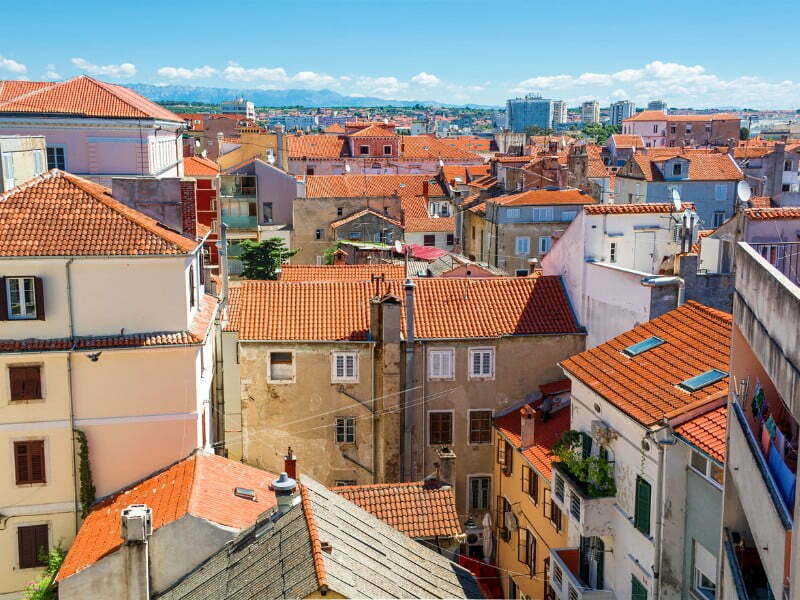
Zadar
Zadar: A Melange of Historical Splendor on the Dalmatian Coast
Situated on the sparkling Dalmatian Coast, Zadar unveils as a city where the echoes of antiquity blend seamlessly with the vibrancy of contemporary life. A hub of cultural and historical treasures, Zadar is a city rich in heritage, with Roman and Venetian ruins coexisting harmoniously amidst modern architectural marvels.
Offering a unique charm, Zadar captivates its visitors with its compelling mixture of history, creativity, and culinary delights. Whether it’s exploring ancient ruins, listening to the symphony of the sea, or savoring delectable Dalmatian cuisine, Zadar promises a truly immersive Croatian experience.
source: Samuel and Audrey on YouTube
Unforgettable Experiences: The Sea Organ and The Sun Salutation
Two of the city’s most extraordinary attractions are the Sea Organ and the Sun Salutation. The Sea Organ, a unique architectural sound art installation, plays music by way of sea waves and tubes located underneath a set of large marble steps. As the waves crash into the tubes, harmonious sounds emanate, creating a natural symphony that transforms the seafront into a soothing concert venue.
Nearby, the Sun Salutation, designed by the same architect, Nikola Bašić, is a solar-powered public installation that creates a vibrant light show. As night falls, this 22-meter diameter circle filled with three hundred multilayered glass plates comes to life, illuminating in rhythm with the waves’ melodies and creating a magical spectacle of light and sound.
Savoring Zadar: Local Food and Drink Specialties
Zadar’s gastronomy is a testament to its cultural richness, providing an exciting journey for the palate. Traditional Dalmatian cuisine, heavily influenced by Italian and Mediterranean styles, features prominently on local menus. Freshly caught seafood, locally grown olives, and renowned Pag cheese are among the culinary highlights that await visitors.
Zadar is also known for Maraschino, a distinctive cherry liqueur that has been produced in the city since the 16th century. This sweet, slightly nutty drink is a must-try for visitors and serves as a perfect way to toast an unforgettable Croatian adventure.
Zadar, with its rich tapestry of historical ruins, innovative attractions, and tantalizing cuisine, stands as a mesmerizing gem on Croatia’s Dalmatian coast. By seamlessly integrating its rich past with dynamic modernity, the city presents a captivating and multifaceted travel destination, bound to enthrall and inspire all who visit.
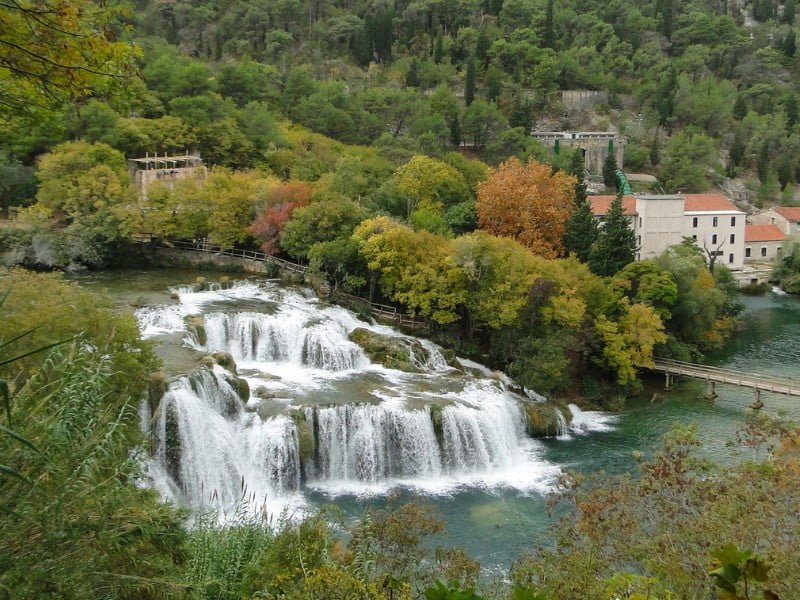
Krka National Park
Krka National Park: A Symphony of Waterfalls in the Croatian Wilderness
Immersed in the verdant heart of Croatia lies Krka National Park, a sanctuary where nature’s grandeur unfurls in a breathtaking spectacle of waterfalls, rivers, and rich biodiversity. This sprawling reserve, covering more than 100 square kilometers, is home to a series of seven magnificent waterfalls that cascade through the lush landscape, creating a haven of natural beauty and tranquillity.
Krka National Park serves as a vivid testament to Croatia’s natural wealth, offering its visitors a unique opportunity to encounter the country’s diverse flora and fauna up close. Here, the harmonious symphony of tumbling waters, rustling leaves, and melodious birdsong weaves an enchanting serenade that reverberates through the park’s expansive terrain.
source: Gabriel Traveler on YouTube
The Dance of Waters: Skradinski Buk and Roski Slap Waterfalls
The park’s crowning glories are, undoubtedly, the Skradinski Buk and Roski Slap waterfalls. Skradinski Buk, the largest and most popular waterfall, is a dramatic cascade of 17 natural barriers, falling over a 800-meter-long stretch. Its terraced pools and thunderous cascades create an awe-inspiring spectacle, revered as one of Europe’s most beautiful calcium carbonate waterfalls.
Roski Slap, another stunning feature of the park, presents a broader, more tranquil scene. Composed of a series of cascades and islets, Roski Slap captivates visitors with its serene beauty. Its unique backdrop of traditional watermills, faithfully restored, adds a touch of human history to the natural panorama.
A Dip into Nature: Swimming in the Park’s Enchanting Pools
Unlike many national parks, Krka invites visitors to not just observe its beauty from afar, but to literally immerse themselves in its allure. Certain sections of the park are open for swimming, particularly near Skradinski Buk. The opportunity to plunge into the crystal-clear, cool waters beneath the majestic falls is a unique, exhilarating experience, offering a refreshing respite from the Croatian summer heat.
Swimming here isn’t merely about the physical act; it is a full sensory experience, where the roar of the falls, the scent of the surrounding vegetation, the taste of the freshwater, and the sight of the sun-dappled landscape merge into an unforgettable memory.
Krka National Park, with its dramatic waterfalls, lush greenery, and inviting swimming spots, stands as a captivating natural sanctuary within Croatia. Whether exploring its scenic trails, marveling at its cascading waters, or indulging in a refreshing swim, a visit to Krka is an immersive journey into the heart of Croatia’s unparalleled natural splendor.
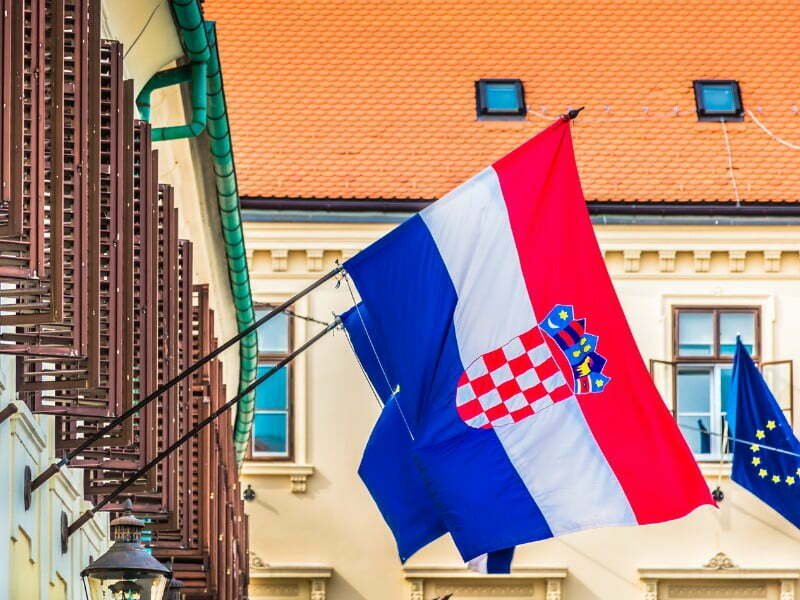
Conclusion: Retracing the Journey: Croatia’s Ten Stunningly Beautiful Destinations
As we reach the terminus of our exploration, we look back upon the ten stunningly beautiful destinations that constitute the heart of Croatia’s allure. Each place, with its distinct charm and character, narrates a unique facet of the Croatian story, painting a vivid, multifaceted picture of this remarkable country.
We embarked on our journey in Hvar, an island blessed with sun-kissed beaches and an enchanting historic town, before setting sail for the “Pearl of the Adriatic,” Dubrovnik, with its imposing city walls and cultural grandeur. We walked the ancient-modern fusion streets of Split, bathed in the golden glow of Brac’s beaches, and savored the idyllic charm of Korcula’s vineyards and olive groves.
We hiked through the verdant trails of Plitvice Lakes National Park, lost ourselves in Rovinj’s romantic lanes, relished the historical riches of Pula, and danced to the natural symphony of Zadar’s Sea Organ. Finally, we immersed ourselves in the emerald pools of Krka National Park, surrendering to the raw, untamed beauty of Croatia’s wilderness.
source: touropia on YouTube
An Invitation to Discovery: Embarking on Your Croatian Adventure
Yet, as enthralling as these descriptions may be, they are but fleeting shadows of the tangible experiences that await in the shimmering seas, ancient cobblestone streets, and verdant landscapes of Croatia. The true magic of this country is revealed in the intimate, personal encounters one cultivates while traversing its diverse terrains, engaging with its rich culture, and connecting with its warm, welcoming people.
Each destination is a canvas upon which you can paint your own unforgettable memories. Whether you’re a history enthusiast, a lover of nature, an adventurous foodie, or a seeker of serene escapes, Croatia invites you to curate your own unique narrative.
Therefore, dear reader, consider this not as a concluding note, but as an invitation – an invitation to step out of the realm of words and pictures, and to step into the vibrant reality that is Croatia. Embark on your journey, explore these stunningly beautiful destinations, and create your own treasure trove of unforgettable Croatian memories. As the proverbial saying goes, “Travel is the only thing you buy that makes you richer.” Enrich your life with the priceless wealth of experiences that Croatia has to offer.

